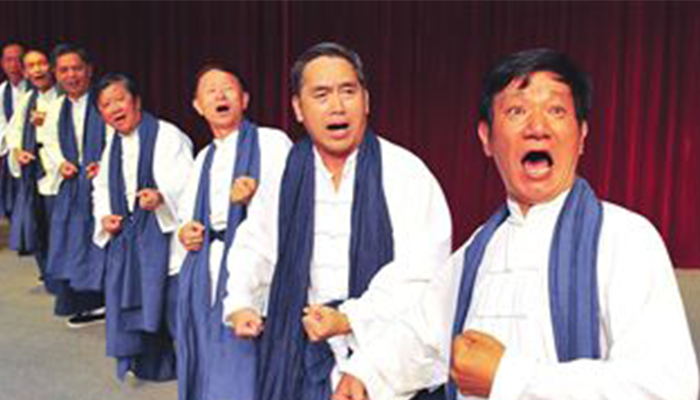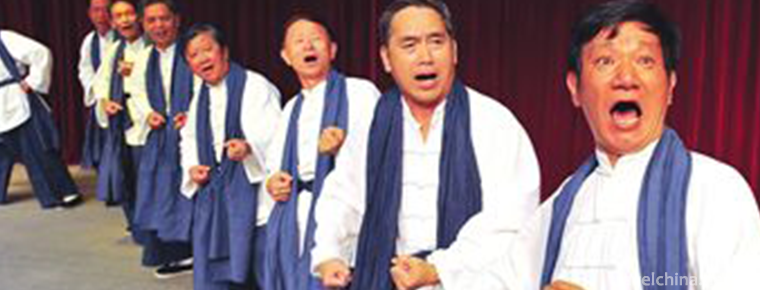Wharf song
Wharf song
The dock number is a traditional folk song in Shanghai. Singing in docks, cargo yards, loading and unloading, lifting, push and pull and other labor occasions. The main singing methods of wharf number are "collar and closure", that is, one person leads, all people gather, or all people lead and all people gather. In the slower pace of labor, the "collar" sentence is longer and the "combination" sentence is shorter. In the tense labor, the "collar" and "he" sentences are very short.
In June 2008, the dock numbers declared by Shanghai Pudong New Area and Yangpu District were listed in the second batch of national intangible cultural heritage lists with the approval of the State Council.
historical origin
In history, "wharf number" has been repeatedly shown publicly. In 1934, Nie Er went to the wharf to experience life, and created the stage play "Yangtze River Storm", in which he composed "The Workman's Song of the Wharf" with "Wharf Number". In 1961, a "Wharf Number" performance was held in the whole port area of Shanghai. According to the newspaper records at that time, the performance presented 19 schools, 108 numbers, and the scene was warm. Later, the Shanghai Port Art and Works Troupe held a nationwide tour and participated in it. In 1986, the British Panshi Film Company sent a special production team to Shanghai to shoot special films with the content of "wharf number" in various ports.
artistic characteristics
It is an artistic labor command order to command people's unified steps and coordinate their actions. Its rhythm and labor rhythm are fully in line, and it is the closest relationship among all folk songs and productive labor practice. The singers are all male, combining "collar" with "harmony", with a wide, loud and multi-treble voice area, which shows the beauty of masculinity.
"41 kilometers long along the Huangpu River, docks stand. Before liberation, people from all over the country came to work here. After liberation, countless wharf workers across the Straits worked here from the first district of Shanggang to the seventh district of Shanggang. Although most of the "wharf number" born in labor are function words such as "say hello" and "hey hello", the music style is distinct and the types are very rich. Reporters learned from the second batch of national intangible cultural heritage recommendation lists that labor codes are divided into dock codes, ocean codes, River codes, forest codes, transport codes and so on. The wharf workers in Shanghai come from all directions. Their demographic structure can be described as "Five Places, Hainabaichuan". Among them are Bengang, Northern Jiangsu Band, Hubei Band and Ningbo Band. At that time, there was a saying that "if you want to enter the wharf, you must know the number first". Therefore, the number of Shanghai Port Wharf not only contains the intonation and rhythm of dialects, but also has the traditional folk singing tune of different places. It is distinct from other chants and has the typical characteristics of Shanghai style. According to the different ways of labor, "Shanghai Port Wharf Number" has also been subdivided into "shoulder-mounted Number", "Bar Number" and "stacking Number", which are quite rich in style.
With the improvement of mechanization and working environment, great changes have taken place in the way of labor carried by hand in the past, and the "wharf number" has gradually lost its existing soil. Today's young people, perhaps only from the old movies in their early years to hear the more exciting "wharf number". Nevertheless, there are still a group of surviving retired dockers who often hum. Tangqiao community has a 60-year-old Mr. Han, who was a trade union cadre in the harbour area. He has recorded and adapted many "wharf numbers". After retirement, he often sings in the old wharf workers organized by the community. They won the prize in the "Chinese Native Folk Song Contest". Relevant organizations also invited 80-year-old retired worker Mr. Cheng from northern Jiangsu to record and collect. Nevertheless, "wharf number" now belongs to the category of "preservation". Hou Xiaosheng believes that "wharf number" is a characteristic element of Shanghai music, but it is very difficult for us to hear this kind of music in film, television, songs and stage works reflecting Shanghai culture. If the dock number is often used in various literary and artistic works, the chances of being known and understood will certainly be much more than being preserved.
Inheritance status
There are many types of wharf number because of different handling objects and environment. The singing of wharf number also forms a unique wharf number with local characteristics and styles due to the different pronunciation of local dialects. Among them, "North Jiangsu Number" and "Hubei Number" are the most representative and popular. The way of inheritance is a kind of "labor inheritance" of natural inheritance.
Nowadays, "wharf number" does not seem to be taken seriously. Hou Xiaosheng has participated in the excavation and collation of "wharf number" for many years. Although nearly 100 "wharf number of Shanghai Port" have been included in "Shanghai Folk Song Integration" by him and his colleagues, he believes: "If all sectors of society can realize the importance of protecting intangible cultural heritage, more tracks should be found." Through his introduction, the reporter learned that some enterprises did not realize the importance of protecting and preserving intangible cultural heritage and were unwilling to provide the archives retained by their predecessors; some departments along the Yangtze River did not support the research of experts and relevant institutions, which made it difficult to find many information and characters about "wharf number". For this reason, some experts pointed out that intangible cultural heritage is a valuable treasure. We should recognize its importance and actively cooperate with the work of excavation, collation and protection so that it will not be obliterated by the changes of the times.


-
2.Shanghai Gulf National Forest Park
Shanghai Bay National Forest Park is located in the May 4th Farm of Haiwan Town, Fengxian District, Shanghai, 60 kilometers from the center of Shanghai. It is a large artificial urban ecological fores
Time 2018-12-19 -
3.Dawakun Desert Tourist Scenic Area
Dawakun tourist scenic spot is located in Tielimu Township, Yuephu County, 6 kilometers away from 310 provincial roads and 110 kilometers away from Kashgar City, with convenient transportation. It is
Time 2019-01-06 -
4.Kunlun Mountains
Kunlun Mountain, formerly known as Kunlunqiu, also known as Kunlunxu, is the god mountain in ancient Chinese legend, the ancestor of Wanshan Mountain, the birthplace of Chinese civilization, and the k
Time 2019-01-29 -
5.Tanxi Mountain Scenic Area
Tanxi Mountain Tourist Area: National AAAA Tourist Area, National Forest Park, National Geopark, National Water Conservancy Scenic Area and Key Scenic Spots in Shandong Province.
Time 2019-02-13 -
6.Ningbo Mud Golden Paint
Ningbo mud gold paint is a local traditional lacquerware process in Zhejiang Province. Chinese raw lacquer is the main raw material. Raw lacquer, also known as big lacquer and real lacquer,
Time 2019-06-07 -
7.Wudang Shenju
Wudang Shenxi Opera is a kind of traditional opera in Xijiadian Town, Danjiangkou City, Hubei Province. It has a history of nearly 400 years since the Wang family absorbed Wudang culture and the music
Time 2019-06-30 -
8.Beijing Forestry University
Beijing Forestry University is a national key university directly under the Ministry of Education and jointly established by the Ministry of Education and the State Forestry and Grassland Administrati
Time 2019-09-06 -
9.Diexi earthquake site
Diexi earthquake site is located 2.5 km southeast of Jiaochang Township, Maoxian County, on the second grade platform on the East Bank of Minjiang River
Time 2020-11-07 -
10.Cultural undertakings in Panzhihua
As of the end of 2018, Panzhihua has 3 museums and exhibition halls; 50 cultural (Art) museums, including 44 cultural stations and 8 theatres and cinemas; and 6 public libraries, with a total collection of 990800 books. There are 43 Township radio and television stations and
Time 2020-12-14 -
11.Leshan peoples life
By the end of 2018, the per capita disposable income of rural residents in Leshan City was 15173 yuan, an increase of 8.9%, and the per capita living consumption expenditure was 12309 yuan, an increase of 9.5%. The per capita disposable income of urban residents
Time 2020-12-17 -
12.Animal resources in Yibin
There are nearly 1000 species of vertebrate resources in Yibin City. Among them, there are 70 species of mammals in 23 families; 306 species of birds in 16 orders, 46 families; 34 species of reptiles in 2 orders, 9 families; 29 species of amphibians; and 151 spe
Time 2020-12-18